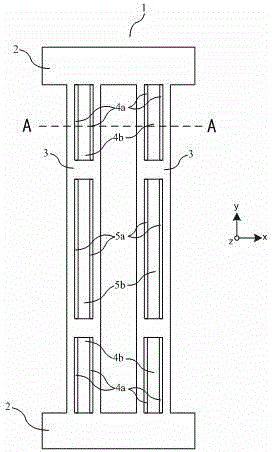Manufacturing method of force sensing resonant element
A technology of resonant components and manufacturing methods, which is applied in the field of sensors, can solve problems such as vibration beam excitation amplitude drop, low electrode excitation efficiency, and poor stability, and achieve the effects of improved excitation efficiency, good consistency, and short distance
- Summary
- Abstract
- Description
- Claims
- Application Information
AI Technical Summary
Problems solved by technology
Method used
Image
Examples
Embodiment 1
[0035] Such as Figure 1a and Figure 1b As shown, a force-sensitive resonant element 1 includes two bases 2 arranged in parallel up and down, and two resonant beams 3 operating in the width bending resonance mode are arranged in parallel and symmetrically between the two bases 2, and the resonant beams The front and back surfaces of 3 are respectively provided with three grooves-the end grooves at both ends and the middle groove between the end grooves. The inner wall of the groove and the two side walls of the resonant beam are respectively covered with electrodes for connecting the excitation power supply. The opening direction of the groove is perpendicular to the vibration direction of the resonant beam, and the two resonant beams are set to vibrate through the direction of the excitation power supply. in the opposite direction. Each end groove is made of two parallel end deep grooves 4a and an end shallow groove 4b between the two end deep grooves and connected with the...
Embodiment 2
[0043] Such as Figure 2a and Figure 2b As shown, the structure of the force-sensitive resonant element of this embodiment is similar to that of embodiment 1, the difference is that the resonant beam 3 is only provided with grooves on one of the front and rear surfaces. To highlight the shape of the cross-section, Figure 2b Electrodes are not shown.
[0044] For thinner resonant beams, when the grooves are made on both sides at the same time, the deep grooves 4a at the end and the deep grooves 5a in the middle are easy to etch through, which reduces the dynamic strength of the resonant beam 3, while the resonant beam 3 resonates. The dynamic impedance will increase, reducing the stability of the force-sensitive resonant element. The structure of the resonant beam 3 with grooves formed on one side in this embodiment is more suitable for the manufacture of a force-sensitive resonant element 1 that is miniaturized and based on a thinner substrate.
Embodiment 3
[0046] Such as Figure 3a and Figure 3b As shown, the force-sensitive resonant element of this embodiment is similar in structure to the force-sensitive resonant element of embodiment 1, the difference is that the middle groove (including the middle shallow groove 5b and the middle deep groove 5a) is not set on the two resonant beams. ). To highlight the shape of the cross-section, Figure 3b Electrodes are not shown.
[0047] When the length of the resonant beam 3 is further shortened, if the front and back sides of the resonant beam 3 are made with a central groove at the same time, the difficulty of electrode patterning on the surface will increase, and the probability of short-circuiting between the first electrode 6a and the second electrode 6b will increase. Both yield and reliability of component fabrication are reduced. The structure of the resonant beam 3 in this embodiment is more suitable for the manufacture of a force-sensitive resonant element with a shorter ...
PUM
 Login to View More
Login to View More Abstract
Description
Claims
Application Information
 Login to View More
Login to View More - R&D
- Intellectual Property
- Life Sciences
- Materials
- Tech Scout
- Unparalleled Data Quality
- Higher Quality Content
- 60% Fewer Hallucinations
Browse by: Latest US Patents, China's latest patents, Technical Efficacy Thesaurus, Application Domain, Technology Topic, Popular Technical Reports.
© 2025 PatSnap. All rights reserved.Legal|Privacy policy|Modern Slavery Act Transparency Statement|Sitemap|About US| Contact US: help@patsnap.com



